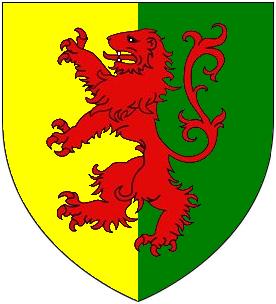Alice of Hainault facts for kids
Quick facts for kids Alice of Hainault |
|
|---|---|
| Spouse(s) | Roger Bigod, 5th Earl of Norfolk |
| Father | John de Avenes, Count of Hainault |
| Mother | Philippine, daughter of Henri II, Count of Luxembourg |
| Died | 26 October 1317 |
Alice of Hainault (died 26 October 1317) was an important noblewoman from the Middle Ages. She was the daughter of John de Avenes, who was the Count of Hainault. Her mother was Philippine, whose father was the Count of Luxembourg. Alice became the second wife of Roger Bigod, 5th Earl of Norfolk, who held the special title of Earl Marshal of England.
Contents
Alice's Family and Early Life
Alice of Hainault was born into a powerful family. Her father, John de Avenes, was the Count of Hainault, Holland, and Zeeland. He also ruled Friesland. Her mother, Philippine, was the daughter of Henri II, the Count of Luxembourg. Alice's father became Count of Holland in 1299. This happened after his cousin, John I, Count of Holland, passed away without any children.
Alice had several brothers. One of them, William III, was a very important person. He was the father of Philippa of Hainault, who later married Edward III of England, a famous English king. This made Alice the great-aunt of a future Queen of England! Another brother was John, Lord of Beaumont. He was known in England as Sir John of Hainault. He played a role in the invasion of England by Isabella of France and Roger Mortimer, 1st Earl of March in 1326.
Marriage to Roger Bigod
Alice married Roger Bigod, 5th Earl of Norfolk. He was the last of the Bigod family to hold the title of Earl of Norfolk. He was also the Earl Marshal of England. This was a very important job in the royal court. It meant he was in charge of organizing royal ceremonies and military matters. Roger Bigod had been married before, but he did not have any children with his first wife.

Alice and Roger Bigod got married around 1290. Their wedding took place at the royal manor of Havering in Essex, England. This marriage was important for England. It helped to strengthen ties with the Low Countries, which included areas like Holland and Hainault. Just two weeks after their wedding, King Edward I of England married his daughter, Margaret, to the Duke of Brabant. This shows how important these family connections were for political reasons.
In 1296, Alice and her husband attended another royal wedding. This was when her father's cousin, John I, Count of Holland, married King Edward I's daughter, Elizabeth.
Life as Countess Marshal
Roger Bigod, Alice's husband, passed away in 1306. He did not have any children with Alice or his first wife. Because of an agreement he had made with King Edward I, his titles went back to the Crown. This meant the King took back the earldom of Norfolk and the office of Earl Marshal.
Even though the titles went back to the King, Alice continued to be known as the Countess Marshal. This shows she was still respected for her connection to such an important position. Years after her death, in 1371, she was still remembered by this title in important documents. For example, Sir Walter Manny, a famous knight, asked monks to pray for her soul in his will.
Alice remained a widow for the rest of her life. After her husband died, she wrote to the Lord Chancellor. She asked him to help one of her husband's long-time clerks get a church position he had been promised. This shows she cared about the people who worked for her and her husband. In 1309, Alice planned a pilgrimage to Santiago de Compostela, a famous holy site. She was given special protection for her journey.
Later Life and Troubles
In 1310, Alice faced a difficult situation. A pirate named John Crabbe attacked a ship carrying her valuable goods. The ship was full of cloth, jewels, gold, and silver, worth a lot of money. King Edward II wrote letters to the Count of Flanders to get justice for Alice. Even though some of Crabbe's men were punished later, Alice did not get her goods back. Because of this, King Edward II ordered that Flemish ships and goods in London be seized. This was to make sure Alice was paid back for her losses.
Alice of Hainault passed away on October 26, 1317. She is believed to have left a will. Years later, in 1333, a priest named John de Framlingham set up a special chapel. This chapel was at Campsey Priory in Suffolk. It was for a chaplain and two assistants to pray for Alice's soul. This shows that she was remembered and respected even after her death.
Images for kids
-
Arms adopted by Alice of Hainault's husband, Roger Bigod, 5th Earl of Norfolk, after he became the Earl Marshal of England
See Also
- Roger Bigod, 5th Earl of Norfolk
- John II, Count of Holland
- Philippa of Luxembourg


